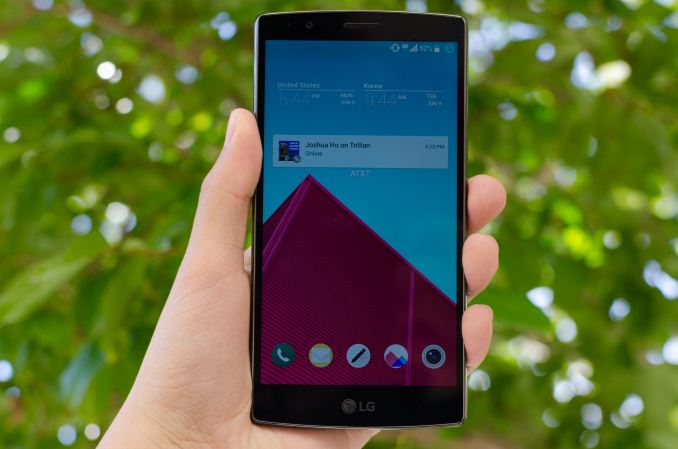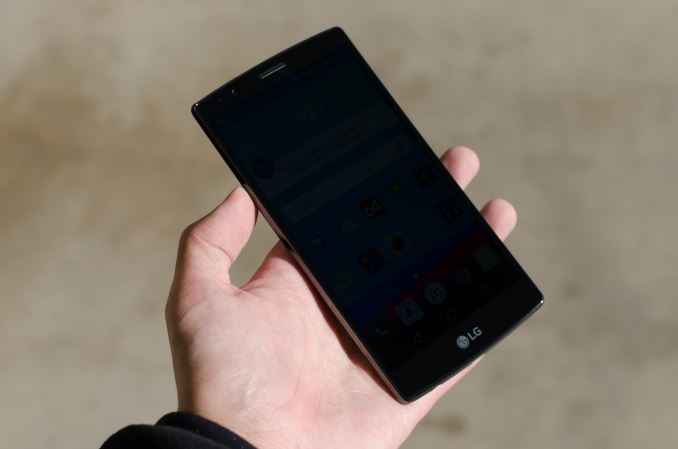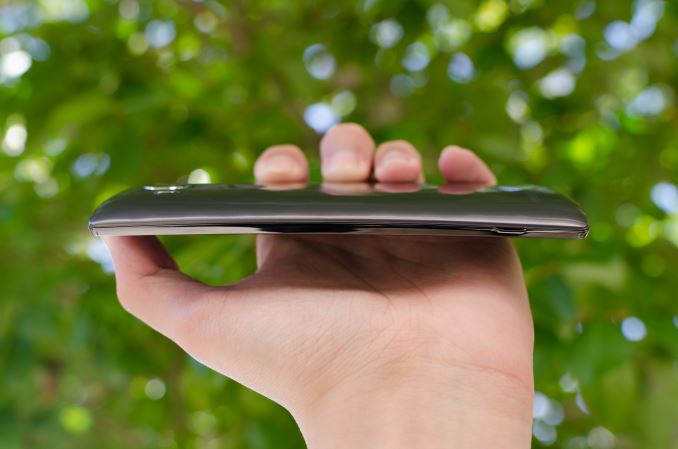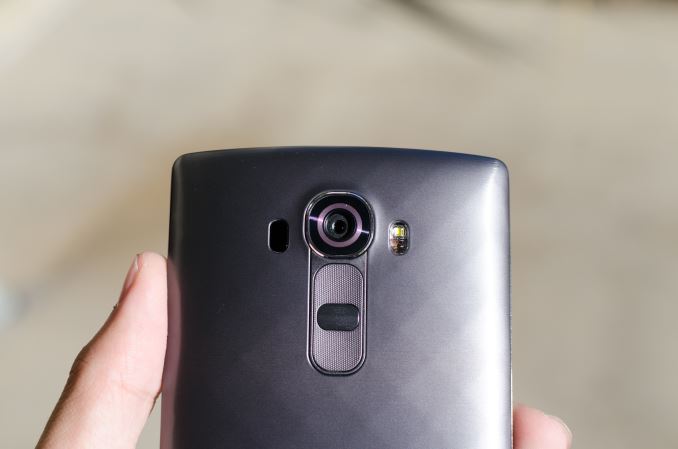The LG G4 Review
by Joshua Ho on July 30, 2015 10:00 AM EST- Posted in
- Smartphones
- Qualcomm
- LG
- Mobile
- Snapdragon 808
- LG G4

The LG G3 was probably the Android phone that was closest to getting everything right last year, but it ultimately fell short of being the “best Android phone”. The camera was the most balanced between the Galaxy S5 and One M8, the design wasn’t quite as nice as the One M8 but definitely better than the Galaxy S5, and LG’s UI fit in relatively well with Android 4.4.
The one flaw that held it back was ultimately the display, which was probably responsible for a lot of the problems that I noticed in the G3. Battery life wasn’t as good as the competition, which was probably due to the new 1440p display. The display itself wasn’t all that impressive either, as there was significant saturation compression and some sharpening effects which really hurt the quality of the display. However, in the context of 2014 flagships it was definitely a valid choice among many that year, as it seemed every device had missed the mark in some way that year.
This brings us to the G4, the successor to the G3. The LG G4 is effectively an evolution of the G3, as we’ll see in the specs below.
LG G3 |
LG G4 |
|
| SoC | MSM8974AC Snapdragon 801 4x Krait 400 @ 2.5 GHz |
MSM8992 Snapdragon 808 2xA57 @ 1.82GHz 4xA53 @ 1.44GHz |
| GPU | Adreno 330 @ 578MHz | Adreno 418 @ 600MHz |
| RAM | 3GB LPDDR3 933MHz | 3GB LPDDR3 933MHz |
| NAND | 32GB NAND (eMMC 5.0) + microSD |
32GB NAND (eMMC 5.0) + microSD |
| Display | 5.5-inch 2560x1440 IPS LCD | 5.5-inch 2560x1440 IPS LCD |
| Network | 2G / 3G / 4G Qualcomm MDM9x25 IP UE Category 4 LTE |
2G / 3G / 4G Qualcomm X10 (Integrated) UE Category 6/9 LTE |
| Dimensions | 146.3 x 74.6 x 8.9 mm 149 grams |
148.9 x 76.1 x 6.3 - 9.8 mm 155 grams |
| Camera | 13MP Sony IMX135 rear camera, 1.12 µm pixels, 1/3.06" CMOS size, F/2.4. 2-axis OIS 2.1MP F/2.0 FFC |
16MP Sony IMX234 rear camera, 1.12µm pixels, 1/2.6" CMOS size F/1.8, 3-axis OIS 8MP Toshiba T4KA3 FFC |
| Battery | 3000 mAh (11.4 Wh) replaceable | 3000 mAh (11.4 Wh) replaceable |
| OS | Android 4.4.2 with LG UI (At launch) | Android 5.1 with LGUX 4.0 (At launch) |
| Connectivity | 802.11a/b/g/n/ac + BT 4.0, USB2.0, GPS/GNSS, Slimport, DLNA, NFC | 802.11a/b/g/n/ac + BT 4.0, USB2.0, GPS/GNSS, Slimport, DLNA, NFC |
| SIM Size | MicroSIM | MicroSIM |
| Price | 199.99 USD on contract (US, launch) ~600 USD retail (US, launch) |
199.99 USD on contract (US, launch) ~649 USD retail (US, launch) |
At a high level, the major changes here have been the upgrade from the Snapdragon 801 to 808 SoC, the new “Quantum IPS” display, and a whole host of changes to the camera that seem to be the focus of the LG G4. The camera seems to really be the centerpiece of this phone, as LG has upgraded the sensor (IMX135 to IMX234), updated the optics, improved the OIS even further, and added a color sensor that looks at visible and IR spectrum to help determine white balance.
Design
As previously discussed, the G4 is very much an evolution of the G3, and this is most apparent when looking at the design of the G4. From the front, there’s relatively little that distinguishes the G4 from the G3, other than a change to the bottom bezel. The design of the phone retains its relatively thin bezels, although the removal of the two-tone bottom bezel definitely makes it feel like the bottom bezel has gotten larger. In the hand, the most noticeable change is that the corners are now noticeably more squared-off in nature. This definitely makes it harder to use the phone with one hand, to the point that I don’t really think this phone is supposed to be used with one hand.
This relatively small change ends up pushing LG over the edge for me when it comes to one-handed usability. I managed to just barely use the G3 with one hand all the time, but with the G4 anything on the left side of the display is now a real stretch to get to, and I basically can’t reach the top-left corner of the display if I’m only using the phone with my right hand. The LG G2 was a comfortably one-handed phone, and the G Pro 2 was a comfortably two-handed phone. The G4 ends up right between those two difference usage paradigms, where some situations allow for one-handed use without issue but others definitely require two hands. At any rate, for those that liked the size of the LG G3 and OnePlus One they’ll probably be right at home with the G4.
The whole phone also has a noticeable curve to it, at a radius of 3000 mm. This radius of curvature is incredibly subtle and in everyday use the phone looks flat, unlike the aggressively curved display of the Galaxy S6 edge. In practice, the real benefit of this curve is to keep the display from touching the surface of a table if the phone is set face-down. The front of the display merges with the side plastic frame, which is slightly higher than the glass to also help somewhat with drop protection. The side plastic frame itself is nothing particularly special to discuss, and is arguably a bit of a regression in feel compared to the G3 due to the glossy nature of the finish. The top of this frame has the IR receiver and transmitter to control TVs and similar appliances, and the bottom has the microUSB port, 3.5mm headphone jack, and a single microphone hole, but there’s otherwise nothing else along the sides of the phone. The rather clean sides are due to the use of rear-mounted power and volume buttons, which is a trademark of LG phones at this point.
The back of the phone is really where most of the changes are on this phone relative to the G3. The dual-tone LED flash is gone, and there’s a color spectrum sensor (RGB + IR) where the amber LED used to be. There’s also a camera hump to accommodate the thicker optics that come with a larger camera sensor, and the back cover has been redesigned on the plastic versions to have a diamond pattern which doesn’t noticeably affect the feel but causes a visual contrast that helps to distinguish this phone from the G3. Unfortunately, we haven’t been sampled the leather back cover so I don’t have anything to really discuss on that front. The single speaker of the phone is also on the back, and appears to be comparable to the G3.
Overall, the design of the LG G4 is decent, but it won’t necessarily impress in the way that the Galaxy S6 might. LG has managed to execute a plastic-bodied phone that doesn’t have any notable issues with look or feel, and given that this build enables a removable battery and microSD slot those that find those features to be a necessity will probably accept this trade-off. I personally would’ve liked to see the speaker either moved to the bottom or front of the phone, but LG has managed to evolve the design of the G3 without any noticeable regressions.














84 Comments
View All Comments
djc208 - Thursday, July 30, 2015 - link
I had the original Optimus G, and it was a great phone hardware wise, but my biggest problem with LG has been their software support. It's getting better but still miserable. They move to new phones so fast that most are barely supported for software for a year. Meanwhile I think Samsung has done a better job of updating and supporting older phones, plus they're so popular the ROMs are more plentiful and well supported. I just couldn't get over the Samsung bloatware, but if you can, they're so close it would probably tip me toward the Samsung based on better software support long term.djw39 - Thursday, July 30, 2015 - link
For the software, if they would just allow for the notification toggles to be hidden by default and appear with a second swipe down, I think that would go a long way. Maybe also give us a normal lockscreen clock too.phoenix_rizzen - Thursday, July 30, 2015 - link
That's my biggest complaint with LG's UI: the lack of usable space on the notification drop-down. There's a scrollable row of quick-toggles, then the volume slide, then the brightness slider, then the shortcuts bar for their quick apps (or whatever they call them), and then, using the last inch of the screen, the actual notifications list!I've tried running the LG stock version of Android on my G2, and always get frustrated with it within a week. Tried the ported ROMs from the LG G3; same frustrations within a week. Even tried the latest ported ROM from the G4; didn't last more than 3 days.
The AOSP-based ROMs have some stability issues, and don't have access to all the camera features, but usability-wise, they are light-years ahead of LG. Even the minimalist ParanoidAndroid provides a better experience than LG, with BlissPop and AICP being even better.
ThisIsChrisKim - Thursday, July 30, 2015 - link
At least on the G4, you can disable all but the quick toggles row. That's how I have mine configured.cjb110 - Thursday, July 30, 2015 - link
As I bought one of these yesterday (once the Moto X was announced as 5.7"), this was a very interesting read. One of the other reviews mentioned that due to the thinness of the bezels its not that hard to hold, which I'd agree. I'd also say LG did a reasonable job on the OS side, most of the crap can be turned off (like taking the picture), and rest is useful (smart settings is a simple but capable 'automation' job. I have replaced the launcher with Google Now, mainly as LG's far left page didn't seem to really do anything useful. One thing I didn't see mentioned that their circle cases (with a watch'esq gap on the front) replace the back and Add wireless charging, BUT you can't get one of these cases in the leather.ZeDestructor - Thursday, July 30, 2015 - link
And still no Xperia Z* review :(piroroadkill - Thursday, July 30, 2015 - link
Heh, right? I'd /still/ buy a Z3 Compact over anything else.BMNify - Friday, July 31, 2015 - link
Sony does not send review samples to Anandtech, so you won't get Xperia reviews.ZeDestructor - Friday, July 31, 2015 - link
Maybe, but sometimes you have to pay up from your own pocket and buy your own review samples, or get a loaner device from somewhere. I mean, GSMarena gets samples, as does arstechnica, so I don't see why AT can't.Personally, if I were in the US, I'd actually happily have sent in my Xperia Z and Z2 when they were freshly released and new for review... Hell, I'd even do it now if there is interest, but nobody wants to see the review for a phone over a year old (nevermind that none of the new flagships bring any useful improvements over it...).
BMNify - Friday, July 31, 2015 - link
You cannot expect Anandtech to buy devices as they review loads of things in different digital/tech sectors often costing thousands of dollars, so they stick to the single site-wide policy of review samples which every major company sends them, only Sony does not send devices to Anandtech.It will be awesome if you can send new devices to Anandtech, i am sure they will appreciate it and even return after few weeks, hope you do send the next Sony xperia, specially the compact ones.